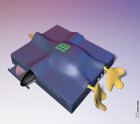My ESP EC-1000QM
Introduction
I bought this guitar in Japan as a gift to myself for reaching a personal goal. They had just dropped the price from $1,000 to $800. I intentionally bought the version with Seymour Duncans because I am a huge fan of theirs.Look and Feel
This is by far the best guitar Ive ever owned in terms of look and feel. It looks fantastic (almost too flashy for church use). It feels very solid, very good. Everything works as advertised. Note that I put fingernail polish on my knobs for a quick visual reference.Body and Finish
The body is finished impeccably. Not a single flaw. I love the way it looks.Electronics
I think the 59/JB combo is probably the most flexible pickup combination from Seymour Duncan (except maybe the Hotrodded Jazz/JB combination). I can cover everything I need for church, and (within reason) drop tunings dont cause the guitar to mush out. The JB can handle old school metal (think Metallica / Panterra / Megadeth) but at the same time not sound out of place in church.The only shame is that the pickups are not wired for splitting like on some of ESPs later guitars. But that being said, Im sure if I look under the electronics cover, Im going to see the pigtails for the other wires, capped off. So I can have the guitar wired with splits and other cool combinations if I want, I just havent done so yet.
Why, do you ask? I like having options. One option I fell in love with from the Fender Showmasters is the parallel coil neck sound, and/or with the bridge split. This allows someone to convincingly (to anyone but someone with a great ear for sound) mimic some Stratocaster and Telecaster quack.
As well, Ive owned an ESP with the HotRodded combo before, and having the ability to split the pickups helped quite a bit as well.
One other thing I would like is if the middle position on the 3 way switch split both pickups and put them in third humbucker wiring. I find that sound to be much more desirable than simply both humbuckers unsplit together. On some arrangements (though not this guitar), both humbuckers unsplit and together is too muddy.
I like the other controls, such as volume and tone, but I do not like having a master tone. I prefer one tone and one volume per pickup so that going back and forth between woman tone (neck pickup with the tone rolled all the way down) and back to a more normal tone.
The controls are smooth and the speed knobs easy to read. The locking tuners are also very good to use: theyre stable and make changing strings very quick.
Playability
This guitar is very easy to use. Its predictable and reliable. The 59 has its usual buttery vintage sound (that in my opinion only sounds right on mahogany, see my Showmaster page) which goes well with many styles, and especially church. I keep the tone at maximum so that rolling it half way down (in what Porcupine Tree dubbed lonely Swede sound) is a significant change in sound, and not just another setting.I both love and am tired of the JB bridge. I love it because it instantly cuts through the mix, and sounds like the stereotypical rock sound of many bands, including the Deftones. But I also dont like it as much as the Full Shred due to its high-mids spike. So to my ears it sounds almost too stereotypical. But it does sound great nonetheless.
For church, this means I can dial in a typical mild crunch sound (think Blues Driver, etc) and then if I want to solo, just switch to the bridge. The difference in volume is what I have become accustomed to, and I love this method of easily switching from lead to crunch.
The 59 can pull off plenty of solos when needed, if you bump up the compressor or mids. Youll be rewarded with beautiful neck leads.
Overall, I find the 59/JB sound in a mahogany guitar to be just about perfect. But honestly, Id prefer a Custom 5 bridge, only because my ears are almost tired of hearing the JB. Nevertheless, the JB is a good pickup, even if it has become sort of a love/hate thing with some players.
Drawbacks
As I said before, the drawbacks are no splits for the coils and the bridge being a JB (though this drawback is very minor). I have no need for active electronics, so this guitar is great. One less thing to be changing batteries in (as I run almost everything else in my rig except my amp on batteries).One other potential drawback is there is no tremolo tail. I dont need one personally, but I can see it being a drawback to someone else.
Finally, I wish this thing had an Earvana nut. I can tell the difference in tuning, and having played an Earvana nut ESP guitar before, I fell in love with the sound.
Conclusion
If you want a guitar you can depend upon for church use, and for most other uses to include some metal (though not NuMetal), this is your guitar. It is dependable, rock solid, works well and feels great. I love this guitar because I know that I can take it to almost any style jam and be able to cover 99% of the bases. Its a very good guitar. You should consider owning one.




